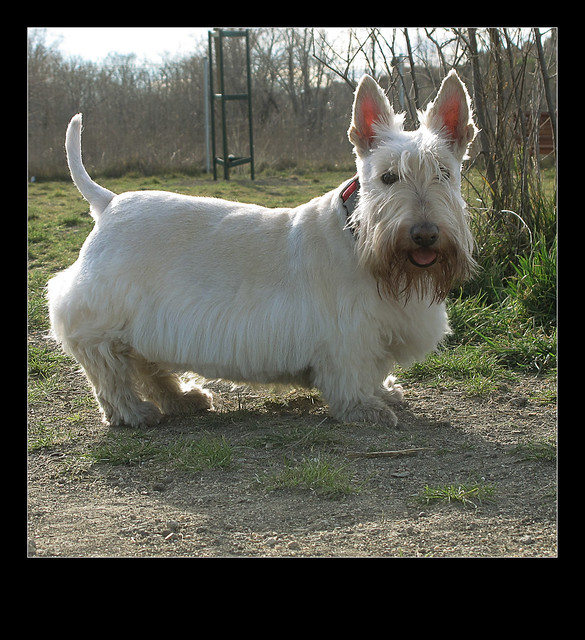 |
| A white Scottish Terrier puppy (Photo credit: Wikipedia) |
History. The Scottish Terrier was, as you may expect, first bred in Scotland, in the 1700s. Originally named Aberdeen Terrier, after the Scottish city, this is a particularly old breed, and parts of its history are steeped in myth and legend, as there is little to no supporting documentary evidence, although, a breed of dog whose description matched the Scottish Terrier was written about in 1436.
Temperament.
The Scottish Terrier breed is generally lovable, hardy, and brave. Being full of character and playful, they mature into dignified and charming adults. They make good watchdogs and will alert you to any problems they perceive. They train quite well, but can be stubborn and have been known to dig their heels in. They tend to be sensitive to criticism, and need to be handled in a gentle but firm fashion. As an intelligent dog they require to know who the master is, they must not be allowed to think they are in charge or this could lead to endless problems in later life. When training or handling this dog any command given must be in a manner that shows you mean it, and you must mean it or the dog will know, and may just ignore you. Whilst this is a very playful dog and loves nothing more than to dash about; care must be taken not to play particularly aggressive or combative games, such as challenging the dog to rope tugging. However such games can be played with members of the family who are not his master, this is because the dog may see the contest as a leadership challenge if conducted by the person he sees as the pack leader.
Health issues.
The Scottish Terrier can suffer from a fairly unique illness called Scottie Cramp (which is a problem in movements). Also are prone to Von Willebrand's disease, jaw problems, skin conditions, and flea allergies. Their life expectancy is 12 to 15 years.
Grooming.
The Scottish Terrier will require brushing regularly, of their wiry coat, during moulting more care should be taken and brushing to be more frequent. Bathing can be conducted as necessary or dry shampooing. Their hair will require being trimmed professionally twice a year. Apart from when they are moulting, they tend to shed little hair, if any at all.
Living conditions.
While the Scottish Terrier prefers cooler climates, it is very happy living in most homes. They are entertaining and get on very well with children, and as they are fairly small, they are unlikely to knock people over. As long as they are adequately exercised they will take well to living in an apartment.
For more information on different Dog Breeds, Dog Training and Teacup Puppies for sale including Yorkies, Chihuahuas and Morkies please visit our websites below.
Scottish Terrier - Puppies or Dogs Article Source: EzineArticles |


